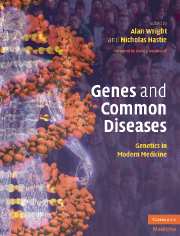Book contents
- Frontmatter
- Contents
- List of Contributors
- Foreword
- Section 1 Introductory Principles
- Section 2 Common Medical Disorders
- 13 Developmental disorders
- 14 Genes, environment and cancer
- 15 The polygenic basis of breast cancer
- 16 TP53: A master gene in normal and tumor suppression
- 17 Genetics of colorectal cancer
- 18 Genetics of autoimmune disease
- 19 Susceptibility to infectious diseases
- 20 Inflammatory bowel diseases
- 21 Genetic anemias
- 22 Genetics of chronic disease: obesity
- 23 Type 2 diabetes mellitus
- 24 Genetics of coronary heart disease
- 25 Genetics of hypertension
- 26 Obstructive pulmonary disease
- 27 Skeletal disorders
- 28 The genetics of common skin diseases
- 29 Molecular genetics of Alzheimer's disease and other adult-onset dementias
- 30 Major psychiatric disorders in adult life
- 31 Speech and language disorders
- 32 Common forms of visual handicap
- 33 Genetic and environmental influences on hearing impairment
- 34 Pharmacogenomics: clinical applications
- Index
- References
28 - The genetics of common skin diseases
Published online by Cambridge University Press: 17 August 2009
- Frontmatter
- Contents
- List of Contributors
- Foreword
- Section 1 Introductory Principles
- Section 2 Common Medical Disorders
- 13 Developmental disorders
- 14 Genes, environment and cancer
- 15 The polygenic basis of breast cancer
- 16 TP53: A master gene in normal and tumor suppression
- 17 Genetics of colorectal cancer
- 18 Genetics of autoimmune disease
- 19 Susceptibility to infectious diseases
- 20 Inflammatory bowel diseases
- 21 Genetic anemias
- 22 Genetics of chronic disease: obesity
- 23 Type 2 diabetes mellitus
- 24 Genetics of coronary heart disease
- 25 Genetics of hypertension
- 26 Obstructive pulmonary disease
- 27 Skeletal disorders
- 28 The genetics of common skin diseases
- 29 Molecular genetics of Alzheimer's disease and other adult-onset dementias
- 30 Major psychiatric disorders in adult life
- 31 Speech and language disorders
- 32 Common forms of visual handicap
- 33 Genetic and environmental influences on hearing impairment
- 34 Pharmacogenomics: clinical applications
- Index
- References
Summary
Introduction
Clinical practice suggests that diseases of the skin are common in most world populations. Exactly how common is, for the majority of conditions, impossible to say, as population defined studies for most skin diseases have not been carried out. In the UK, probably typical of many first world countries, about 1:6 consultations in primary care is for a skin disorder, more than for any other disease grouping (McCormick et al., 1996). Of these 1:6 consultations, 25% are for atopic dermatitis, 20% for other forms of dermatitis, 25% for acne, and 10% for psoriasis (McCormick, Fleming and Charlton, 1996). The cumulative incidence of atopic dermatitis and other forms of eczema is perhaps 30% (Williams, 1997). Psoriasis affects 2–3% of the population (Naysmith and Rees, 2003), and skin cancer is the commonest human malignancy in Northern European populations, accounting for half of all cancer cases (Marks, 1995); (Rees, 1998).
Skin disease prevalence data is predictably more limited for third world countries, but point incidence rates of skin disease are in the order of 20–30%, with a greater proportion than in first world countries being due to infectious causes (e.g. fungal disease, infestations, leprosy) (Satimia et al., 1998). Even in the absence of rigorous worldwide studies, it seems reasonable to assume that the frequency of diseases of the skin is higher than that of any other organ.
- Type
- Chapter
- Information
- Genes and Common DiseasesGenetics in Modern Medicine, pp. 427 - 438Publisher: Cambridge University PressPrint publication year: 2007



